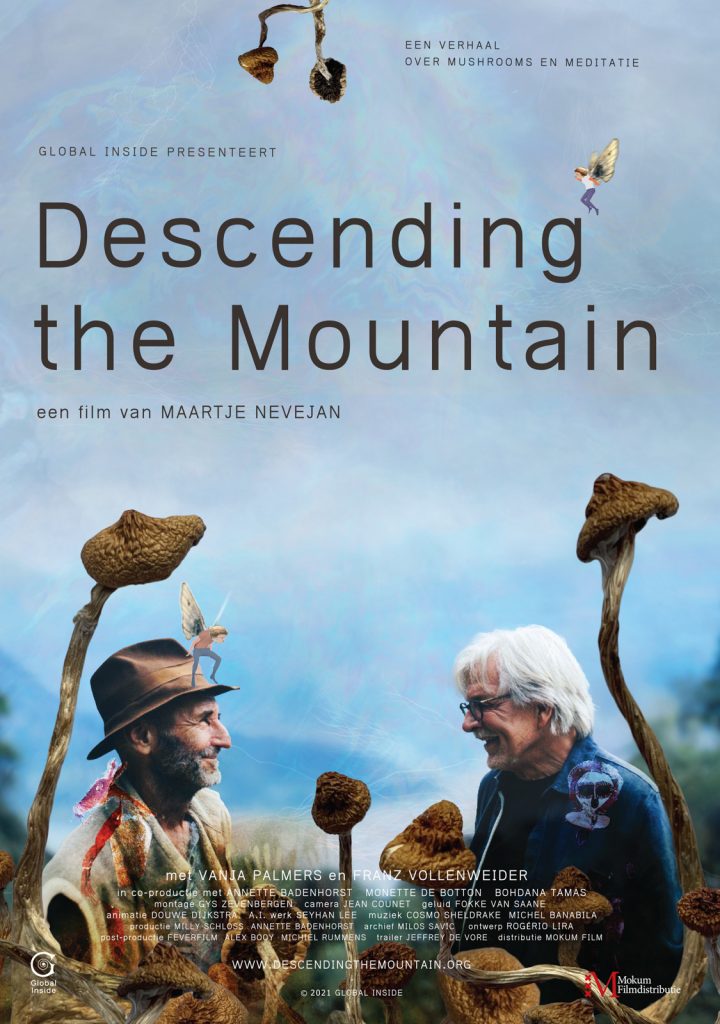While taking a psychedelic journey—such as with psilocybin mushrooms or LSD—many people have the experience of being in the presence of sacredness or touching the essence of spirituality. On a very successful “trip” you may not feel any separation from the journey itself. It’s an aspect of the experience that is rarely depicted in films, which tend to focus on the auditory and visual hallucinations that can be directly reproduced on screen. The movies that attempt to convey this spiritual dimension often end up creating a caricature. But the new documentary Descending the Mountain succeeds where others have fallen short, managing to an amazing extent to produce a vicarious experience of being high on psilocybin.
Shot at beautiful Felsentor Foundation, a Buddhist retreat center on majestic Mount Rigi in Switzerland, the film is a true account of what happened when psychiatric researcher Franz Vollenweider and Zen master Vanja Palmers created this groundbreaking and successful experiment.
Interest in psychedelic mushrooms is booming—having less to do with tripping for entertainment than for the potential aid to one’s health, mental and physical, as well as deep spiritual enrichment. Today, every university of high quality in the United States and Europe has researchers in psychedelic science. Michael Pollan, author, Harvard professor, and guru of the plant world, called himself a “reluctant psychonaut” and wrote a book called How to Change Your Mind.
Now fully out of the psychedelic closet, Pollan points to several good reasons why he thinks psychedelics like psilocybin mushrooms, MDMA, and LSD have amazing potential for humanity: multiple clinical studies have already revealed effective lessening of depression, anxiety, PTSD, obsessive-compulsive disorder, alcohol use disorder, and tobacco use disorder. Pollan believes that another reason to enlist the help of psychedelics is the shocking degree of tribalism present in current human culture. As we all know, human society is the architect of the environmental crisis, and yet the crisis is largely ignored.
Experienced psychedelic explorers like Franz Vollenweider and Vanja Palmers fully realize the exigencies of exploring the mind with psychedelics. In the 1960s and ’70s many young people had psychedelic experiences in Buddhist zendos, but they eventually faced criticism from the very people who would be most able to blend psychedelics with disciplined ritual.
For much of the film one is struck by its sincerity, as well as by its religious and scientific rigor—and its spontaneous humor, such as when Franz Vollenweider smacks his head on a zendo beam, or the coining of the phrase “extreme placebos.” Much of the film’s charm comes from the very likable Zen master Palmer. The scenery is exemplary, and the spontaneous intercuts of music and visuals unquestionably enrich the experience.
Cosmo Sheldrake, the composer son of the sound healer Jill Purce and the biologist and author Rupert Sheldrake (known for his notion of morphic resonance, which asserts that memory is inherent in nature and present in ecological systems), and the Dutch composer Michel Banabila are credited for the film’s enthralling and hypnotic music, and sound effects play a powerful role—delicate yet transfixing. Beautifully documented is the unity of pigs, goats, birds, and plants. The visuals, along with stunning animation, sounds, and strong use of artificial intelligence, create exceptional effects.
Directed by Maartje Nevejan, Descending the Mountain was an offering of the San Francisco–based International Buddhist Film Festival. All in all, I like feeling that Zig Zag Zen, my anthology of essays about Buddhism and psychedelics, is a kind of spiritual companion to the unique and lovely film Descending the Mountain.
Thank you for subscribing to Tricycle! As a nonprofit, we depend on readers like you to keep Buddhist teachings and practices widely available.
